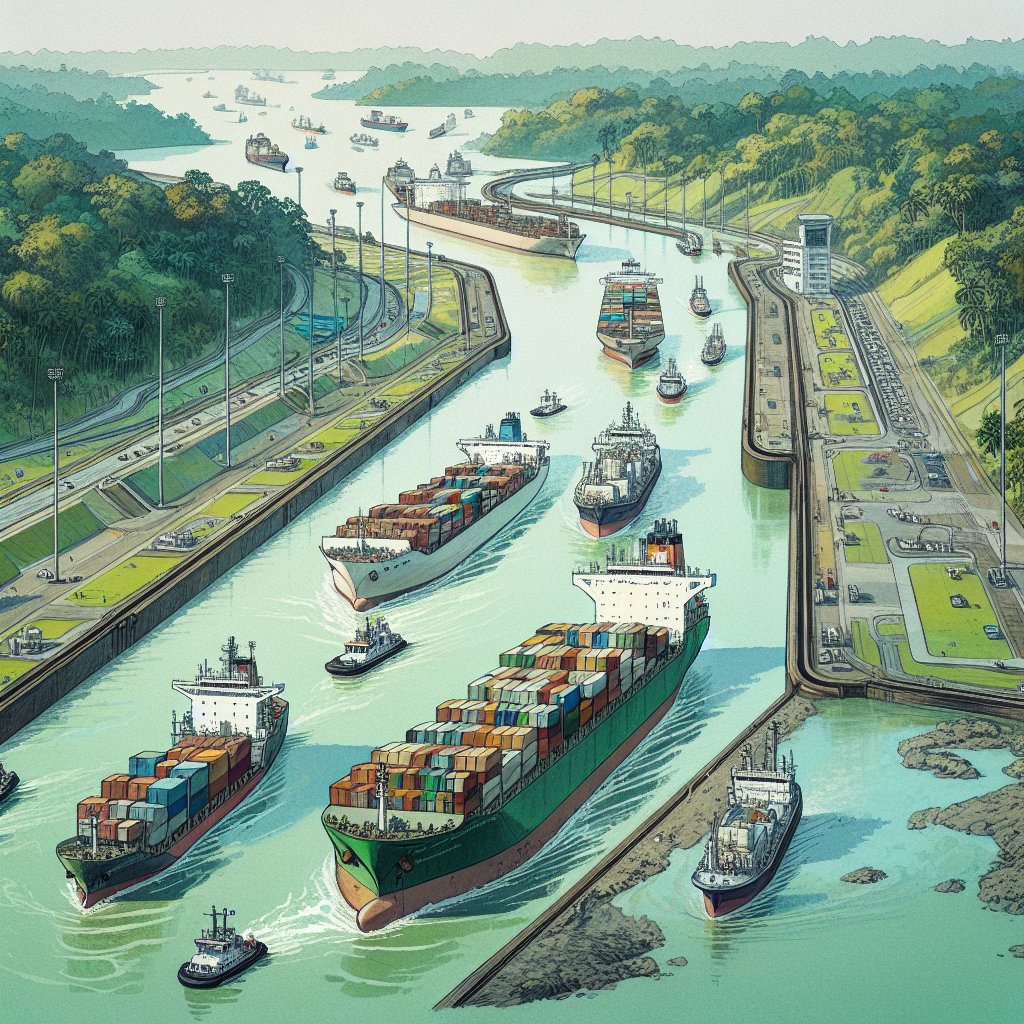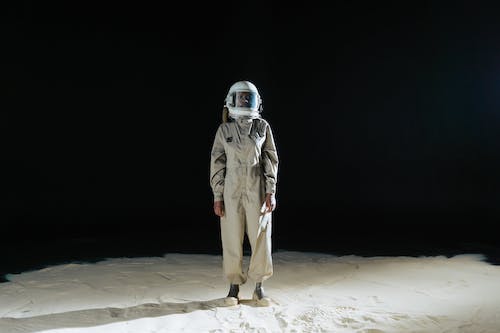The Panama Canal, one of the most famous waterways in the Americas, is facing a critical water shortage. Unlike the Suez Canal, which is fed by seawater, the Panama Canal relies on freshwater from Lake Gatún. However, due to a lack of rain and the El Nino weather phenomenon, the water level in the lake is falling dangerously low. This has led to water-saving measures and weight restrictions on ships passing through the canal, affecting global trade. The Panama Canal Authority is working on sustainability projects to ensure the canal does not run out of water, including water conservation measures and the construction of reservoirs. However, these projects require approval and will take several years to complete. Desalination plants and cloud seeding are also being considered as potential solutions. The changing rainfall patterns serve as a reminder of the impact of climate change on global trade and the future of the Panama Canal.
Original news source: Can the Panama Canal save itself? (BBC)
🎧 Listen:
Slow
Normal
Fast
📖 Vocabulary:
| 1 | critical | Extremely important or essential |
| 2 | freshwater | Water that is not salty, often used for drinking and irrigation |
| 3 | phenomenon | An observable event, especially one that is unusual or difficult to understand |
| 4 | sustainability | The ability to maintain ecological and environmental health over the long term |
| 5 | reservoirs | Artificial lakes used to store water |
| 6 | desalination | The process of removing salt from seawater to make it usable |
| 7 | conservation | The act of preserving natural resources and protecting the environment |
| 8 | approval | Formal consent or agreement |
| 9 | global | Relating to the entire world |
| 10 | trade | The action of buying, selling, or exchanging goods and services |
| 11 | construction | The act of building or assembling structures |
| 12 | solutions | Methods or plans proposed to solve a problem |
| 13 | patterns | Repeated sequences or occurrences |
| 14 | impact | The effect or influence of one thing on another |
| 15 | reminder | A cue or prompt that serves to remind or warn |
Group or Classroom Activities
Warm-up Activities:
– News Summary
Instructions: Have students read the article individually or in pairs. Then, ask them to write a summary of the key points of the article in their own words. Afterward, have a class discussion where students share their summaries and compare their answers.
– Vocabulary Pictionary
Instructions: Select 10-15 vocabulary words from the article and write them on the board. Divide the class into teams and give each team a piece of paper and a marker. One student from each team comes to the front and picks a word from the board. They have to draw a picture to represent the word, and their team has to guess the word within a certain time limit. The team that guesses the most words correctly wins.
– Pros and Cons
Instructions: Divide the class into small groups and give each group a sheet of paper. Ask them to create a list of pros and cons related to the water shortage at the Panama Canal. After a few minutes, have each group share their lists with the rest of the class. Encourage a class discussion where students can debate the advantages and disadvantages of the situation.
– Think-Pair-Share
Instructions: Give students a few minutes to individually think about and write down their ideas on how the Panama Canal can address the water shortage. Then, pair up the students and have them share their ideas with each other. Afterward, have a class discussion where students can share their partner’s ideas and discuss the different solutions proposed.
– Future Predictions
Instructions: Ask students to imagine and write down their predictions for the future of the Panama Canal, considering the water shortage and the impact of climate change. After a few minutes, have students share their predictions in small groups. Then, have a class discussion where students can share their group’s predictions and discuss the likelihood of each scenario.
🤔 Comprehension Questions:
1. What is the main cause of the water shortage in the Panama Canal?
2. How does the water shortage affect global trade?
3. What measures is the Panama Canal Authority taking to address the water shortage?
4. How long will it take for the sustainability projects to be completed?
5. What are some potential solutions being considered to address the water shortage?
6. What is the impact of climate change on the Panama Canal?
7. How does the Panama Canal get its freshwater supply?
8. What is the current water level in Lake Gatún?
Go to answers ⇩
🎧✍️ Listen and Fill in the Gaps:
The Panama (1)______, one of the most (2)______ (3)______ways in the Americas, is facing a critical water shortage. Unlike the Suez Canal, which is fed by seawater, the Panama Canal relies on freshwater from Lake (4)______. However, due to a lack of rain and the El Nino weather (5)______, the water level in the lake is falling dangerously low. This has led to water-saving (6)______ and weight restrictions on ships passing through the canal, affecting (7)______ trade. The (8)______ Canal Authority is (9)______ on (10)______ (11)______ to ensure the canal does not run out of water, including water conservation measures and the construction of reservoirs. However, these projects require approval and will take (12)______ years to (13)______. (14)______ plants and cloud seeding are also being (15)______ as potential solutions. The changing rainfall patterns serve as a (16)______ of the impact of climate change on global trade and the future of the Panama Canal.
Go to answers ⇩
💬 Discussion Questions:
Students can ask a partner these questions, or discuss them as a group.
1. What is the significance of the Panama Canal in global trade?
2. How would you feel if you were a ship captain and had to deal with weight restrictions due to the water shortage in the Panama Canal?
3. Do you think the Panama Canal Authority’s sustainability projects will be successful in ensuring the canal does not run out of water? Why or why not?
4. What are some potential consequences of the water shortage in the Panama Canal on global trade?
5. How do you think the water-saving measures implemented in the Panama Canal will impact the shipping industry?
6. Do you think desalination plants and cloud seeding are viable solutions to the water shortage in the Panama Canal? Why or why not?
7. How do changing rainfall patterns due to climate change affect water resources around the world?
8. What are some other examples of the impact of climate change on global trade?
9. How important is it for countries to have alternative water sources, like reservoirs, in case of water shortages?
10. How do you think the water shortage in the Panama Canal will affect the economies of countries that rely on the canal for trade?
11. Do you think the water shortage in the Panama Canal will have long-term effects on global trade? Why or why not?
12. How would you feel if you were a resident living near Lake Gatún and had to deal with the consequences of the water shortage?
13. What are some potential solutions to address the impact of climate change on water resources?
14. How do you think the construction of reservoirs will impact the ecosystem around the Panama Canal?
15. Do you think the water shortage in the Panama Canal is a wake-up call for countries to take action on climate change? Why or why not?
Individual Activities
📖💭 Vocabulary Meanings:
Match each word to its meaning.
Words:
1. critical
2. freshwater
3. phenomenon
4. sustainability
5. reservoirs
6. desalination
7. conservation
8. approval
9. global
10. trade
11. construction
12. solutions
13. patterns
14. impact
15. reminder
Meanings:
(A) The process of removing salt from seawater to make it usable
(B) Water that is not salty, often used for drinking and irrigation
(C) Methods or plans proposed to solve a problem
(D) Artificial lakes used to store water
(E) Formal consent or agreement
(F) The act of building or assembling structures
(G) An observable event, especially one that is unusual or difficult to understand
(H) Extremely important or essential
(I) A cue or prompt that serves to remind or warn
(J) Repeated sequences or occurrences
(K) The act of preserving natural resources and protecting the environment
(L) The ability to maintain ecological and environmental health over the long term
(M) The effect or influence of one thing on another
(N) Relating to the entire world
(O) The action of buying, selling, or exchanging goods and services
Go to answers ⇩
🔡 Multiple Choice Questions:
1. What is causing the water shortage in the Panama Canal?
(a) Seawater contamination
(b) Overuse of freshwater by ships
(c) Lack of rain and El Nino weather phenomenon
(d) Construction of reservoirs
2. How does the Panama Canal differ from the Suez Canal?
(a) The Panama Canal is longer than the Suez Canal
(b) The Panama Canal relies on freshwater from Lake Gatún, while the Suez Canal is fed by seawater
(c) The Suez Canal is located in the Americas, while the Panama Canal is located in Egypt
(d) The Suez Canal has weight restrictions on ships, while the Panama Canal does not
3. What measures have been implemented to conserve water in the Panama Canal?
(a) Desalination plants and cloud seeding
(b) Construction of reservoirs
(c) All of the above
(d) Water-saving measures and weight restrictions on ships
4. How long will it take to complete the sustainability projects in the Panama Canal?
(a) A few months
(b) One year
(c) It is uncertain
(d) Several years
5. What potential solutions are being considered to address the water shortage in the Panama Canal?
(a) Water conservation measures and weight restrictions on ships
(b) Construction of reservoirs
(c) Desalination plants and cloud seeding
(d) All of the above
6. What impact does the water shortage in the Panama Canal have on global trade?
(a) It has no impact on global trade
(b) It affects global trade due to weight restrictions on ships passing through the canal
(c) It increases global trade due to the construction of reservoirs
(d) It decreases global trade due to the lack of rain
7. What is the Panama Canal Authority doing to ensure the canal does not run out of water?
(a) Working on sustainability projects, including water conservation measures and the construction of reservoirs
(b) Implementing weight restrictions on ships passing through the canal
(c) Building desalination plants
(d) None of the above
8. What does the water shortage in the Panama Canal highlight?
(a) The impact of climate change on global trade and the future of the canal
(b) The need for more ships to pass through the canal
(c) The importance of seawater in waterways
(d) The effectiveness of cloud seeding in increasing rainfall
Go to answers ⇩
🕵️ True or False Questions:
1. The demolition of reservoirs and water conservation measures are part of the sustainability projects.
2. The water surplus in the Panama Canal is benefiting global trade.
3. The Panama Canal Authority is working on sustainability projects to address the water shortage.
4. The Panama Canal relies on freshwater from Lake Gatún.
5. The water level in Lake Gatún is rising dangerously low.
6. The lack of rain and the El Nino weather phenomenon are contributing to the water shortage in the Panama Canal.
7. Water purification plants and rain enhancement are being dismissed as potential solutions for the water shortage in the Panama Canal.
8. Water-saving measures and weight restrictions have been implemented for ships passing through the canal.
Go to answers ⇩
📝 Write a Summary:
Write a summary of this news article in two sentences.
Writing Questions:
Answer the following questions. Write as much as you can for each answer.
1. What is causing the critical water shortage in the Panama Canal?
2. How are weight restrictions on ships affecting global trade?
3. What measures is the Panama Canal Authority taking to ensure the canal does not run out of water?
4. What are some potential solutions being considered to address the water shortage?
5. What does the water shortage in the Panama Canal reveal about the impact of climate change on global trade?
✅ Answers
🤔✅ Comprehension Question Answers:
1. The main cause of the water shortage in the Panama Canal is a lack of rain and the El Nino weather phenomenon.
2. The water shortage affects global trade by leading to water-saving measures and weight restrictions on ships passing through the canal.
3. The Panama Canal Authority is taking measures such as water conservation and the construction of reservoirs to address the water shortage.
4. The sustainability projects being undertaken by the Panama Canal Authority will take several years to complete.
5. Potential solutions being considered to address the water shortage include desalination plants and cloud seeding.
6. The changing rainfall patterns due to climate change have an impact on the water levels in the Panama Canal and its future sustainability.
7. The Panama Canal gets its freshwater supply from Lake Gatún.
8. The current water level in Lake Gatún is falling dangerously low.
Go back to questions ⇧
🎧✍️✅ Listen and Fill in the Gaps Answers:
(1) Canal
(2) famous
(3) water
(4) Gatún
(5) phenomenon
(6) measures
(7) global
(8) Panama
(9) working
(10) sustainability
(11) projects
(12) several
(13) complete
(14) Desalination
(15) considered
(16) reminder
Go back to questions ⇧
📖💭✅ Vocabulary Meanings Answers:
1. critical
Answer: (H) Extremely important or essential
2. freshwater
Answer: (B) Water that is not salty, often used for drinking and irrigation
3. phenomenon
Answer: (G) An observable event, especially one that is unusual or difficult to understand
4. sustainability
Answer: (L) The ability to maintain ecological and environmental health over the long term
5. reservoirs
Answer: (D) Artificial lakes used to store water
6. desalination
Answer: (A) The process of removing salt from seawater to make it usable
7. conservation
Answer: (K) The act of preserving natural resources and protecting the environment
8. approval
Answer: (E) Formal consent or agreement
9. global
Answer: (N) Relating to the entire world
10. trade
Answer: (O) The action of buying, selling, or exchanging goods and services
11. construction
Answer: (F) The act of building or assembling structures
12. solutions
Answer: (C) Methods or plans proposed to solve a problem
13. patterns
Answer: (J) Repeated sequences or occurrences
14. impact
Answer: (M) The effect or influence of one thing on another
15. reminder
Answer: (I) A cue or prompt that serves to remind or warn
Go back to questions ⇧
🔡✅ Multiple Choice Answers:
1. What is causing the water shortage in the Panama Canal?
Answer: (c) Lack of rain and El Nino weather phenomenon
2. How does the Panama Canal differ from the Suez Canal?
Answer: (b) The Panama Canal relies on freshwater from Lake Gatún, while the Suez Canal is fed by seawater
3. What measures have been implemented to conserve water in the Panama Canal?
Answer: (d) Water-saving measures and weight restrictions on ships
4. How long will it take to complete the sustainability projects in the Panama Canal?
Answer: (d) Several years
5. What potential solutions are being considered to address the water shortage in the Panama Canal?
Answer: (c) Desalination plants and cloud seeding
6. What impact does the water shortage in the Panama Canal have on global trade?
Answer: (b) It affects global trade due to weight restrictions on ships passing through the canal
7. What is the Panama Canal Authority doing to ensure the canal does not run out of water?
Answer: (a) Working on sustainability projects, including water conservation measures and the construction of reservoirs
8. What does the water shortage in the Panama Canal highlight?
Answer: (a) The impact of climate change on global trade and the future of the canal
Go back to questions ⇧
🕵️✅ True or False Answers:
1. The demolition of reservoirs and water conservation measures are part of the sustainability projects. (Answer: False)
2. The water surplus in the Panama Canal is benefiting global trade. (Answer: False)
3. The Panama Canal Authority is working on sustainability projects to address the water shortage. (Answer: True)
4. The Panama Canal relies on freshwater from Lake Gatún. (Answer: True)
5. The water level in Lake Gatún is rising dangerously low. (Answer: False)
6. The lack of rain and the El Nino weather phenomenon are contributing to the water shortage in the Panama Canal. (Answer: True)
7. Water purification plants and rain enhancement are being dismissed as potential solutions for the water shortage in the Panama Canal. (Answer: False)
8. Water-saving measures and weight restrictions have been implemented for ships passing through the canal. (Answer: True)
Go back to questions ⇧












